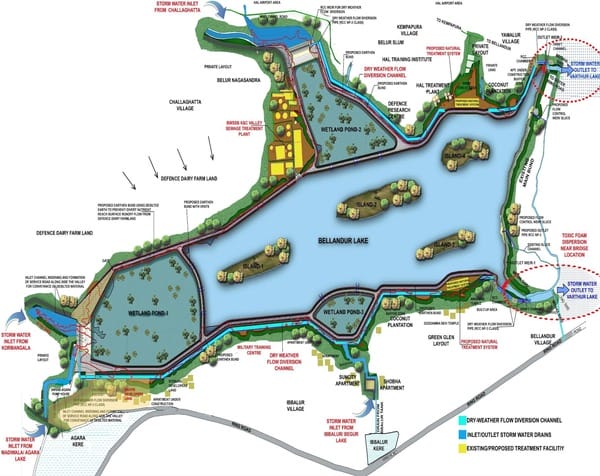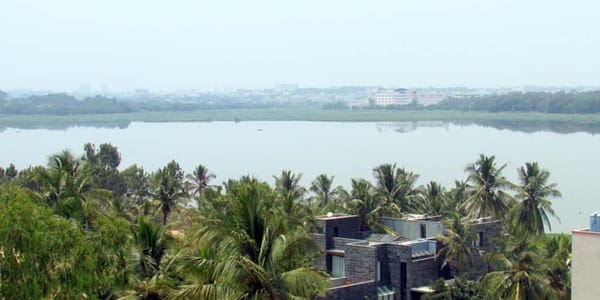Bathymetric study conducted by Madras Engineering Group division of the Indian Army and scientists from IISc. Pic: Akshatha M
April 12th, 2016
A team of active citizens of Bengaluru representing community groups – Whitefield Rising and Save Bellandur Lake Group – assemble on the fringes of Bellandur lake to address the media. They are accompanied by a team of researchers from Indian Institute of Science and army personnel from Madras Engineering Group (MEG).
The reason: To brief the media about a community-funded survey to evaluate the condition of Varthur and Bellandur lakes.
April 13th, 2016
Another set of active citizens under the banner of Namma Bengaluru Foundation (NBF) assemble at Sri Venkateshwara Swamy temple premises located on another edge of Bellandur lake. This programme is attended by elected representatives including Bengaluru Development Minister K J George and Rajya Sabha members Rajeev Chandrashekhar and Rajeev Gowda.
The reason: To hand over the Save Bellandur Action Plan to the minister. The plan has been drafted by NBF after conducting a study for three months.
A view of Bellandur lake that sprawls over 800 acre land. Pic: Akshatha M
Everyone wants the lakes saved
While there has been a hue and cry over the pathetic condition of Bellandur lake and demands to save deteriorating water bodies, this time, two separate citizen led groups have made a move towards protecting two infamous lakes of Bengaluru.
The Bathymetric Study of Varthur and Bellandur lakes is a combined effort from citizen groups, Indian Institute of Science and Madras Engineering Group (MEG), a division of the army. This study is perceived as a first step towards understanding the current state at the inter-connected Bellandur and Varthur lakes. The study has been taken up following expert recommendations on the need to dredge the lakes to remove silt and sludge.
Energy and Environment expert Prof T V Ramachandra from Indian Institute of Science, who is spearheading the bathymetric survey of both the lakes, strongly pitches for desilting as a primary solution to rejuvenate the lake. The survey is under progress and the study report is likely to be released within a month.
Prof Ramachandra explains the survey and the probable solutions to restore the two lakes. He says the minimum depth of Bellandur lake was 10 metres in 1970, whereas now it has reduced to 5.4 metres. For Varthur lake, the minimum depth was 5 metres three and a half decades ago and now it is decreased by half (2.5 metres).
“To understand the lakes, we are studying them by taking into account physio-chemical and biological parameters. Bathymetric survey comprises of studying the silt, depth, water quality and aquatic life in the lake. It will help us to know the aquatic plants and species in the lake, water contamination, what contamination is absorbed by the plants etc.,” he says.
The team of 12 researchers are collecting water and silt samples from various points of the lake (at a distance of 5 metres), right from the cleanest part of the lake to the most contaminated area.
Selling the silt and restoring the lake
Prof T V Ramachandra does not just point out the problems that these two lakes face, but offers solutions too. When the government agencies are reluctant to fund the lake restoration projects, apparently due to lack of funds, the professor says that the solution is simple. “The lake silt is of high economic value. The lake should be desilted, the silt should be sold and the same amount could be used for restoration work.”
According to the preliminary information gathered during bathymetric study, the silt accumulated in Varthur and Bellandur lakes is worth Rs 1,800 crore. This amount is enough to restore both the lakes. Normally, contractors who desilt the lake, earn a lot of profit by selling the silt. The value of silt is underestimated. With a proper planning, the silt could be sold in the market and used for the lake restoration, the professor points out.
While he recommends for wet dredging and removing silt and sludge as the first step to revive the lake, he also says the next step should be to construct STPs at inlet points so as to ensure that no sewage enters the lake. Varthur and Bellandur lakes could be revived in 24 months, he predicts.
Save Bellandur Action Plan by NBF
Namma Bengaluru Foundation’s report, Save Bellandur Action Plan was released and handed over to the Bengaluru Development Minister, K J George. This report explains a step-by-step solution to rejuvenate Bellandur lake. Some of the proposed solutions include – dewatering, desilting and removal of sludge, stopping untreated sewage inflow and outflow and use the treated water for tertiary purpose. The plan has been prepared after consulting 11 subject experts.

Bellandur lake map with solutions proposed by NBF. Pic: NBF
According to the action plan, estimated cost of rejuvenating Bellandur lake is Rs 400 crore with an implementation period of three years. Read the full action plan here.
Since this Action Plan too needs bathymetric survey to be done before implementing, Citizen Matters asked NBF Chief Executive Officer Sridhar Pabbisetty on collaborating with the community group which is already conducting bathymetric survey. He said they were ready to take inputs from the ongoing study.
‘No money!’
Meanwhile, Bengaluru Development Minister K J George who was present at the programme indicated his inclination towards breaching the lake to drain it out. He said there are two solutions to Bellandur lake problem – one is temporary and the other is permanent. Permanent solution needs few hundred crores, whereas temporary solution can be done with Rs 15 crore.
According to the minister, temporary solution to the problem is by deweeding and doing a bit of desilting and break open the waste weir. “Let experts give their advice on breaking open the weir. We will take up short term solution through the BDA, irrespective of criticism,” he said.
However, owing to opposition for breaking open the lake weir from citizen teams, everyone agreed to conduct a workshop to study the pros and cons of breaching the lake.
It could be recalled that in last October, Bellandur residents had decided to breach the lake as they were fed up with the legal route for cleaning Bellandur lake.
